Building A Backyard Pickleball Court
(Scroll Down The Page For Information About An Alternative Solution; A Portable Backyard Pickleball Court For Less Than $200)
Are you considering a backyard pickleball court for your home? The popularity of pickleball has resulted in overcrowded public courts, which has created windfall opportunity for contractors to shift their focus from general landscape services to this lucrative new niche.
The cost to homeowners ranges from about $20,000 to well over $50,000. To better understand what you are paying for, a bid for a backyard pickleball court usually includes the following elements:
-Preparing The Court Location
This first phase is also the most important, and unless your contractor has considerable knowledge and experience building backyard pickleball courts, any failures in this step will likely result in problems down the road. It isn’t as simple as choosing a 30’x60′ flat area to build on. The ground that will be supporting your court surface must be stable, precisely graded, and have proper drainage. If any of these are not done properly, changes in temperature, excessive rain and/or snow, and settling earth will eventually likely result in cracks.
-Court Base
The least expensive home pickleball courts are built on an asphalt base, with concrete being the more expensive (and theoretically longer lasting) option. In most climates, even with a proper vapor barrier, an asphalt base will likely crack; in this step, you should expect to get what you pay for. Before moving on to the next step, it is important that your base has cured for at least 30 days, followed by an acid etching and pressure washing process to prepare it to “hold” the surface.
-Court Surface
On top of a properly cured & etched base is a latex or epoxy primer coat which essentially becomes the playing surface. Though only a thin layer is rolled onto the base, this is what changes the feel of the court from cement or asphalt to what we would describe as an “athletic surface”. An even more “athletic surface” is achieved by repeating the process, adding multiple thin layers of acrylic, and optionally mixing in granulated rubber particles.
-Paint
Once the proper structural and surfacing steps are complete, the color combinations are totally up to you, subject only to personal preference. That said, precision with measuring and painting the boundary lines is critical. Don’t worry…if your taste in colors changes, resurfacing and repainting happen all the time and are not difficult as long as the earlier steps have been done right.
-Post, Anchor & Net
Again, precision is key in this step. For a regulation court, posts must be set properly, preferably in a ground sleeve, perfectly vertical to the ground, and at extending to the proper height for a 3′ net. Although you may not be hosting any USPA sanctioned events on your backyard pickleball court, playing on a net that measures exactly 36″ at the ends and 34″ in the center will help you practice hitting the ball into the net just high enough that it trickles over for the win when you do play in sanctioned tournaments. Just kidding…that “shot” is just lucky. We wish you luck!
Game Action Video Clips:
How Do You Play Backyard Pickleball On A Grass Court?
1. Smaller Court Dimensions:
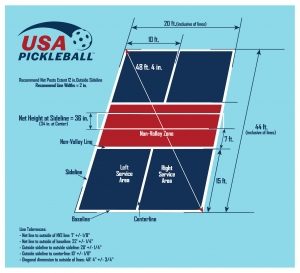
We adjusted the court size to accommodate for the fact that players can’t move as fast on grass or sand, and every shot is a volley since the ball doesn’t bounce.
In comparison to pickleball, Sandy Pickle’s boundaries are slightly smaller, and the center line has been eliminated.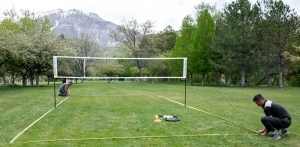 The singles* court width is 13′ 6″ (4.1 meters), and doubles is 16′ 8″ (5.1 meters), with baselines at 16′ for singles and 18′ for doubles.
The singles* court width is 13′ 6″ (4.1 meters), and doubles is 16′ 8″ (5.1 meters), with baselines at 16′ for singles and 18′ for doubles.
*SandyPickle’s proprietary net design allows for easy width adjustment between singles & doubles.
2. Adjustable Net Height
For the same reasons as in #1, the net needed to be raised from the standard 36 inch pickleball height.
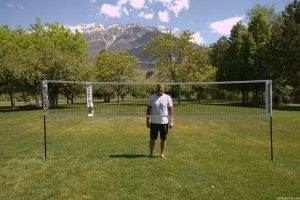
For recreational play, the net should be set to the approximate height of the tallest player on the court. For tournament play, the default height is 6’ but may be modified to accommodate for optional height and/or skill divisions.
3. No-Spike Zone
The area within 5’ of the net on each side is called the “No Spike Zone” (similar to the “Kitchen” in pickleball).
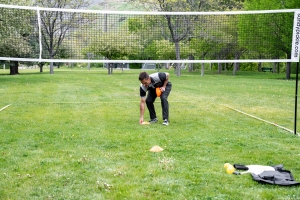 On each serve, the return must be made from behind the no-spike zone; At all other times, the only restriction to playing inside this area is that no part of the paddle may be above the top of the net when making contact with the ball (i.e. no spiking).
On each serve, the return must be made from behind the no-spike zone; At all other times, the only restriction to playing inside this area is that no part of the paddle may be above the top of the net when making contact with the ball (i.e. no spiking).
4. No Bounces
Balls don’t bounce well on sand or grass, therefore each shot must be hit before the ball touches the ground.
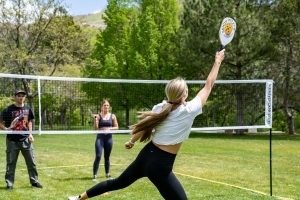 Sometimes described as a hybrid of pickleball and badminton, Sandy Pickle also borrows the “bump” from volleyball. The addition of the 1-pass rule in doubles play allows a player to bump, or pass to their teammate who then must hit the ball over the net on the subsequent shot.
Sometimes described as a hybrid of pickleball and badminton, Sandy Pickle also borrows the “bump” from volleyball. The addition of the 1-pass rule in doubles play allows a player to bump, or pass to their teammate who then must hit the ball over the net on the subsequent shot.
Longer, volley-only rallies make for a fast-paced game that is almost as fun to watch as it is to play!
5. Serving
Serves are made from behind the baseline with no limitations as to which side of the court they are hit from or to. Also unlike pickleball, players may serve overhead.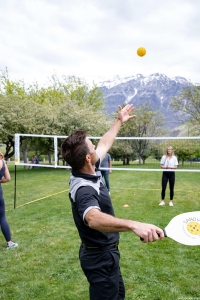
A serve is “out” if it lands within the no-spike zone or outside court boundaries. If the ball hits the net but lands within the boundaries, it is a “let” and the serve is repeated. The player serving continues until they lose a point, after which their opponent takes over (unlike pickleball, in doubles play the serve alternates sides at the end of each serving opportunity).
6. Scoring
Like pickleball, games are played to 11 points and must be won by 2 (or more). A point is earned when the player or team serving wins the point. If the player or team RECEIVING the serve wins the point, they take over the serve.
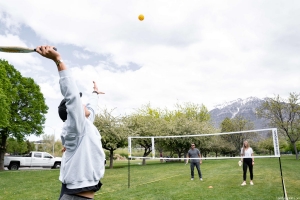 Scoring Note: When a team is winning 7-6, for example, the player serving would call out “7-6” rather than “7-6-1”.
Scoring Note: When a team is winning 7-6, for example, the player serving would call out “7-6” rather than “7-6-1”.


